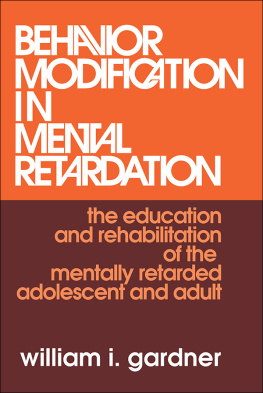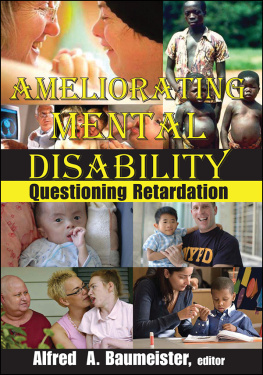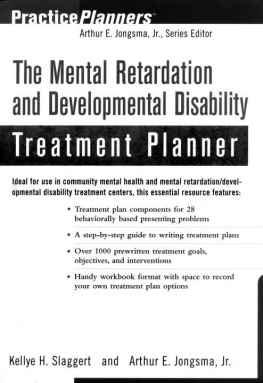BEHAVIOR
MODIFICATION
IN
MENTAL
RETARDATION
BEHAVIOR
MODIFICATION
IN
MENTAL
RETARDATION
the education
and rehabilitation
of the
mentally retarded
adolescent and adult
william i. gardner
First published 1971 by Transaction Publishers
Published 2017 by Routledge
2 Park Square, Milton Park, Abingdon, Oxon OX14 4RN
711 Third Avenue, New York, NY 10017, USA
Routledge is an imprint of the Taylor & Francis Group, an informa business
Copyright 1971 by William I. Gardner.
All rights reserved. No part of this book may be reprinted or reproduced or utilised in any form or by any electronic, mechanical, or other means, now known or hereafter invented, including photocopying and recording, or in any information storage or retrieval system, without permission in writing from the publishers.
Notice:
Product or corporate names may be trademarks or registered trademarks, and are used only for identification and explanation without intent to infringe.
Library of Congress Catalog Number: 2006045630
Library of Congress Cataloging-in-Publication Data
Gardner, William I.
Behavior modification in mental retardation : the education and rehabilitation of the mentally retarded adolescent and adult / William I. Gardner.
p. cm.
Includes bibliographical references and index.
ISBN 0-202-30857-X (pbk. : alk. paper)
1. People with mental disabilitiesRehabilitation. 2. People with mental disabilitiesBehavior modification. I. Title.
HV3004.G37 2006
616.858806dc22
2006045630
ISBN 13: 978-0-202-30857-9 (pbk)
Preface
This book is addressed to all persons involved in the education and rehabilitation of those mentally retarded adolescents and adults who present difficult problems of learning and behavior adjustment. It is written primarily for the rehabilitation personnel involved in the evaluation, training, and vocational adjustment of retarded clients and for those special educators who are involved in the secondary level school program and the program of transition from the school to the work-rehabilitation setting; however, the psychologist, the psychiatrist, the social worker, the training and sheltered workshop supervisor, and others who in one way or another contribute to the rehabilitation effort will find the book relevant to their own specialty areas. These different groups have in common the single function of providing expertise to the program which seeks to support the development of appropriate patterns of behavior in the mentally retarded client. At the same time, these professional groups usually differ widely in the nature of the concepts which they hold concerning the development and modification of behavior patterns of the retarded. This conceptual potpourri frequently results in poor communication, irrelevant activities, and a general lack of efficiency and effectiveness in the education and rehabilitation of the mentally retarded adolescent and adult.
In recognition of these and other difficulties in present efforts with the mentally retarded, this book presents a set of assumptions and related behavior principles concerned with the development and modification of behavioral characteristics. The objectivity of this position provides a basis for evaluation of its therapeutic effectiveness. It focuses on the person as he functions in an environment and emphasizes that the significant variables which control his behavior are found in this environment. This provides a basis for enthusiasm that something can be done in the natural surroundings to facilitate effective behavior change. In a sense, it provides an exciting viable position from which to view the possibilities of modifying the limited behavioral repertoire of the retarded. The positive approach engendered by the position that behavior is modifiableeven in the more severely limited retardedis in marked contrast to the pessimism that is held by many other systems of therapy, education, and training.
No background knowledge of learning concepts nor experience in use of behavior modification techniques is assumed in this book. The behavior concepts are discussed in a nontechnical manner and in as much detail as is deemed necessary to provide the reader with clear understanding of the concepts presented. It is not intended as a comprehensive presentation or documentation of the conceptual model nor of the empirical basis for work with the retarded; however, the reader is introduced to the area of behavior modification and is provided with ample reference materials for more intensive study. To facilitate the acquisition of the concepts and related behavior modification techniques, a procedure of reinforcement through repetition is used by the writer. New concepts, once presented, are frequently rephrased immediately, re-presented in a new context, and later restated and integrated with additional concepts. An effort is made to build constantly on each new concept and to translate each into a workable and useful strategy or procedure of behavior modification. The university student or practicing clinician who is being introduced for the first time to the learning approach to behavior development and modification should find that this approach facilitates his task. The practicing clinician who is familiar with a learning approach can easily skip the repetition and quickly identify new information which may assist him in his contact with his clients.
In a further effort to make the learning concepts and related behavior modification procedures as meaningful and applicable as possible, numerous clinical illustrations, taken from experiences of the writer and his colleagues, are provided. The major focus of the book is on the practitioner who in his daily contact with the learning and behavior problems of the retarded is faced with the questions of what to do and how best to do it. Relevant research results are also presented, where these are available, to emphasize the empirical data basis for many of the ideas represented. It is recognized that the clinical illustrations in many instances can provide only suggestive support for the treatment regimen described, and further that the legitimacy of the presumed relationship between behavior change and the treatment methods utilized must be evaluated with appropriate research. Many of the treatment ideas are just ideas. Most, however, have been generated by an extension from basic behavior principles, or appear to be logical applications of available research data.
Special recognition is extended to those hundreds of retarded adolescents and adults who, even though seemingly in constant conflict with their social environment, have consistently demonstrated that they could learn if the environment would only provide appropriate support. Their failures and frustrations have provided the impetus for members of the rehabilitation team to examine their traditional concepts and methodologies and to explore new models of behavior development and modification.
Contents
C. G. Screven, Joseph A. Straka, Richard LaFond
PART ONE
Problems of Education and Rehabilitation of the Mentally Retarded Client
CHAPTER ONE
Introduction
With the intensive special education and rehabilitation programs provided in numerous communities, most mildly retarded adolescents and young adults are able to enter into a productive vocational life without undue difficulty. The percentage of such persons in any given community is more dependent upon social and economic conditions of the community than upon any pronounced personal deficiencies of the retarded. If sufficient work opportunities are available, most mildly retarded young adults have the basic occupational and personal-social characteristics to make them capable of at least a minimal degree of success in independent work and living without excessive assistance from community educational and rehabilitation resources. Additionally, many moderately and severely retarded persons are able to attain satisfactory adjustment in simple competitive and sheltered workshop environments. The number and quality of rehabilitation programs for this group are growing steadily.









